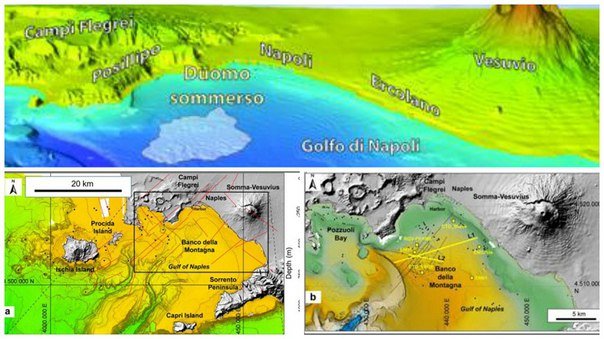Scientists have discovered a dome releasing gases in the Bay of Naples, between the volcano Mount Vesuvius and the active Campi Flegrei caldera during the oceanographic campaigns.
The dome covers an area of 25 square km and has a height of about 15 meters. The new structure sits at depths ranging from 100 to 170 meters.
The findings made on the oceanic research vessel Urania show 35 gas emission spots and 650 small craters linked to the gas emission on the dome, which date back to 12,000 years.
According to the scientists, gas emissions in the Bay of Naples are secondary volcanic phenomena, but are not currently associated with a direct ascent of magma. So we can not talk about magma rising at the surface, but there is evidence in other cases that such gas emissions preceded by hydrothermal explosions and the formation of underwater volcanoes.
Here the abstract of the Nature article:
We report evidences of active seabed doming and gas discharge few kilometers offshore from the Naples harbor (Italy). Pockmarks, mounds, and craters characterize the seabed. These morphologies represent the top of shallow crustal structures including pagodas, faults and folds affecting the present-day seabed. They record upraise, pressurization, and release of He and CO2 from mantle melts and decarbonation reactions of crustal rocks. These gases are likely similar to those that feed the hydrothermal systems of the Ischia, Campi Flegrei and Somma-Vesuvius active volcanoes, suggesting the occurrence of a mantle source variously mixed to crustal fluids beneath the Gulf of Naples. The seafloor swelling and breaching by gas upraising and pressurization processes require overpressures in the order of 2 - 3 MPa. Seabed doming, faulting, and gas discharge are manifestations of non-volcanic unrests potentially preluding submarine eruptions and/or hydrothermal explosions.Sources:
Seafloor doming driven by degassing processes unveils sprouting volcanism in coastal areas
Più che il "duomo" nel Golfo mi preoccupano i Campi Flegrei
Il vulcanologo: "Il "duomo" nel Golfo di Napoli? Mi preoccupano i Campi Flegrei. Lì c'è qualcosa che si muove. E non c'è un piano"




the last time the Plagarean Fields built up gas pressure was when the eruption was closely associated to the Les Champs magnetic field reversal of the entire Earth.
I suggest our Earth is building up gas pressure in the core/mantle boundary and I further suggest the areas of pressurized gas may actually be connected so that the release of gas pressure may actually cause the subsidence of extensive areas of land surface. It may even be that the water stored in deep rocks--stored as hydrogen--could be the undisclosed cause of sea level rise with glacial melting a contributor not the primary factor. [Link]